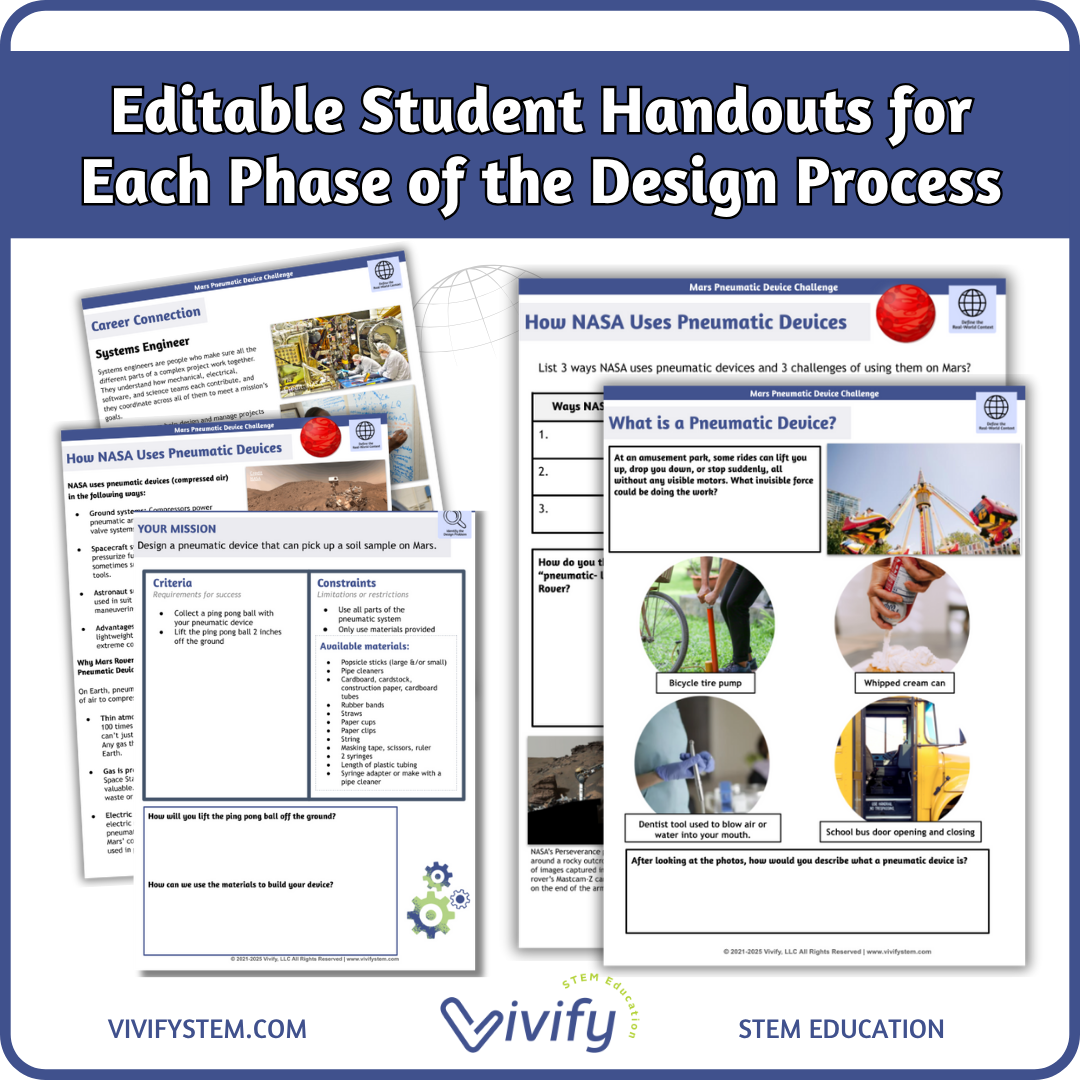“Great for a multi grade level summer camp! ”
Lesson Overview
Design a Pneumatic Device Middle School STEM Unit
Inspired by the true story of NASA systems engineer, Bobby Wei, who develops pneumatic sampling systems for planetary missions, making it possible to collect and study soil from distant planets. In this hands-on challenge, students design and build a pneumatic device to solve the problem of lifting and collecting a Mars soil sample. The unit brings together engineering and physical science topics for an engaging design challenge. Learning from NASA’s use of pneumatics in planetary exploration, students use the engineering design process to build a system that can pick up a ping pong ball (soil sample), lift it 2 inches off the ground, and use all parts of the pneumatic system with only the materials provided. The challenge incorporates key science concepts of air pressure, force, motion, and mechanical systems.
Engineering Our Cosmos Storyline (Adaptable for Grades 6 - 8): Humanity has long looked to the stars with wonder. Now, we stand at the dawn of a new era, where engineers will lead the way to other worlds. Your mission: design the tools, technologies, and systems that enable human exploration and survival beyond Earth. Each challenge brings us closer to life among the stars—and drives innovations that improve life here on Earth. It’s time to start Engineering Our Cosmos!
A Mission to Collect Samples on Mars, Titan, and Beyond: NASA engineer Bobby Wei is a lead system engineer working on NASA's Dragonfly mission at the Johns Hopkins Applied Physics Laboratory. Bobby is responsible for overseeing the development of the pneumatic transfer system, ensuring that all components function together seamlessly to collect and transfer surface material from Saturn’s moon, Titan.
Bobby's work on Dragonfly and other planetary missions is helping pave the way for future exploration of Mars, Titan, and beyond. His efforts are making planetary science safer, smarter, and more accessible for the next generation of explorers.
Engineering Learning Goals in this unit include:
Real-World Connections: Learning what a pneumatic device is and how it is used in everyday life, how NASA uses pneumatic devices, and how Perseverance and Curiosity Rovers use pneumatics.
Making: Using materials to demonstrate pneumatics and how to re-design based on testing data.
Habits of Mind: Working as a team to build a design that solves a problem and communicating ideas and provide feedback to peers.
Science: Exploring and collecting data on pneumatics - compressed air and movement, and understanding how air pressure is related to pneumatics.
Technology: Learning about the technology of robotic rovers on Mars as well as learning about the technology and careers related to using pneumatics.
Math: Using observations to make informed design changes, addition and division problems related to the project, and data tables and graphs.
Included in this product:
Aligned to: NGSS, TEKS, and ITEEA Standards
Complete Teacher Guide following the engineering design process
Materials list and activity suggestions
Editable teaching slides
Editable student handouts for each phase of the design process, including science background, STEM career connection, information on Bobby Wei, and more!
Mission report and badges
Recommended Supplies
Materials for Building:
Popsicle sticks (large &/or small)
Pipe cleaners
Cardboard, card stock, construction paper, cardboard tubes
Rubber bands
Straws
Paper cups
Paper clips
String
Masking tape,
Scissors, ruler
Materials for Testing:
2 syringes
Length of plastic tubing
A syringe adapter or make with a pipe cleaner
(Kits of classroom sets of these supplies can be seen here.)
2021 Science TEKS Standards Alignment (Texas)
Practices: 6.1A-F, 6.2D; 7.1A-F,7.2D; 8.1A-F, 8.2D
Content: 6.8A, 7.7A-B, 8.7A

























